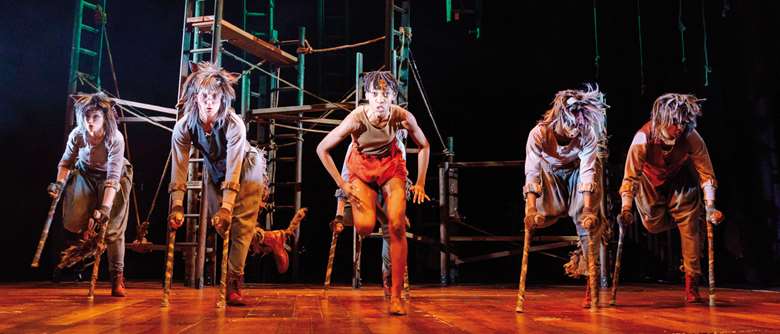The Jungle Book
Jessica Swale
Monday, March 1, 2021
Each issue of D&T we bring you a page-to-stage focus on a play for performance with your students. This issue, professional director Max Webster guides you through Jessica Swale's adaptation of Rudyard Kipling's The Jungle Book with original songs by Joe Stilgoe, published and licensed for performance by Nick Hern Books

Manuel Harlan
The Jungle Book was originally a novel by Rudyard Kipling and then a much-loved Disney film, which tells the story of the orphan Mowgli and how he is brought up in the jungle by animals. We all know and love Baloo the Bear, Bhageera the Panther and Akela the chief wolf. In Jess Swale's wonderfully warm-hearted and funny adaptation, this story becomes about the challenges of growing up, what it feels like to be different and how you find out who you really are.
Context
One of the big challenges of the adaptation was the political context of the original material. The Kipling novel is steeped in colonial ideology; the Disney film draws on racist associations between monkeys and African Americans. Jess was highly aware of this right from the beginning, and her adaptation goes hard the other way, making the story into a celebration of diversity.
Even though Mowgli and the wolves may look different, they learn that accepting and celebrating their differences makes them stronger as a community. What I love about the script is that it delivers such an important message not by being preachy or heavy-handed, but through humour, open-heartedness, and great storytelling.
Music
The other big challenge was that everybody knows the Disney songs. We can all sing along to ‘The Bear Necessities’, so the question was whether people would feel cheated seeing this well-known story without the classic tunes. Our answer was in the form of fantastic new songs by Joe Stilgoe. Jess worked closely with Joe to weave the music throughout the whole play, which gave the production a great sense of celebration and joy.
Design
The story asks all sorts of impossible things from design: a huge rock, fire, a parched landscape, big trees in the jungle. My advice is not to be literal. Use the impossibility as a spur to your imagination. We made the whole jungle world out of ladders and platforms: you could use tables, boxes, umbrellas, or bicycles, or sheets. The jungle is a world of imagination. We know the kids aren't really animals, so it's ok if the trees aren't really trees too.
Casting
When casting the play, it's important to think which performers have the right energy for which character. Who is warm and funny and could be a bear? Who is sleek and mysterious and could be a panther? Also: if you are doing the songs, will they be able to sing them?
In a play that's so much about difference, it's also vital to think about representation in your casting choices. In the original production we were able to work with a very diverse group of actors. This might not be possible in all schools, but you can still cast creatively, and against type and think about the politics of your casting choices. We had a female actor play Mowgli, and you'll notice that their gender is never referred to in the text (it didn't feel like the important part of the story) so you can cast whoever you think best for the role, regardless of their gender.
Directing
My first tip for directing this is to have fun. The more fun you have making it, the more fun the actors will have performing, and the more fun the audience will have. Playfulness is a huge door to good acting. It allows you to stop worrying and really commit. The story has humour, joy and silliness, and this is very much to be celebrated and embraced. Nobody wants to watch someone embarrassed to be a bear.
On the other hand, the play is also a serious story. My second tip is to make it as believable as possible. We have to believe Shere Kahn, the tiger, is genuinely dangerous; the threat of death, drought, abandonment, isolation needs to be felt constantly. The stakes are literally life and death. If played as a pantomime, it can lose its gravitas and emotional traction. We should be crying at the end when Mowgli has to leave.
It will also take time for the actors to work out how to be animals. Crawling around on all fours, we won't see their faces. However, if they just stand upright, we lose anything that's animal about them, so you have to find a balance. It would be worth having some separate movement rehearsals to allow them to develop how they are going to move as an animal.

